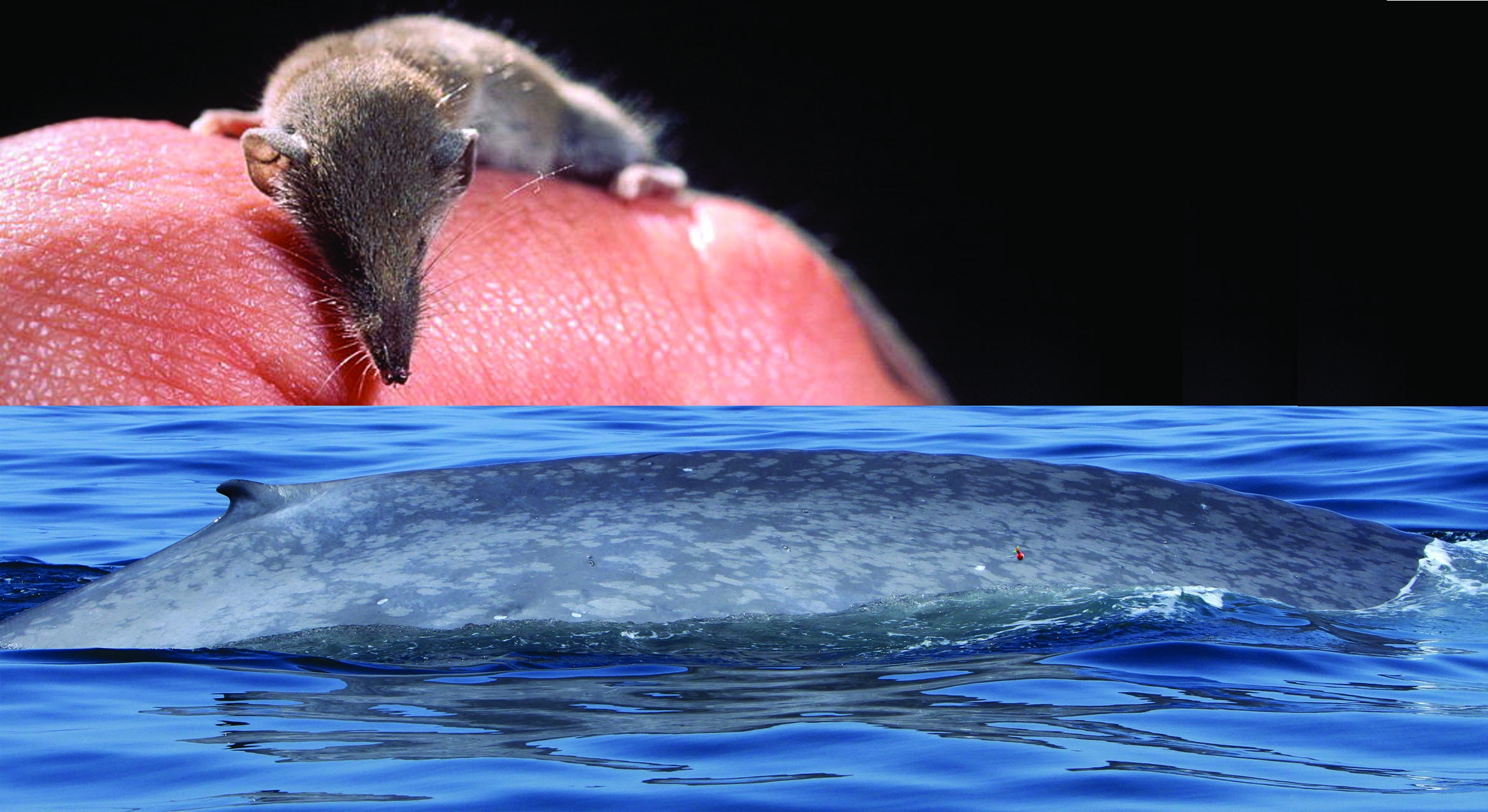
Reference genomes from the world’s largest and smallest mammals pave the way toward solving mysteries of development and lifespan
UC Santa Barbara researcher Susanne Meyer remembers when she went out to collect skin biopsy samples from free roaming blue whales in the Santa Barbara Channel. Standing with her teammates on the deck of a small UCSB boat, Meyer watched as licensed whale researcher Jeff K. Jacobsen aimed his sampling device at the magnificent, giant creatures as they surfaced the waters that morning. Only one attempt per whale was permitted and the risk was high to either miss the target or lose the precious sample in the ocean.
“It was being done with a crossbow and a specifically designed sampling arrow,” said Meyer, who spent the previous year acquiring the appropriate permits to biopsy the whales and establishing the logistics for the event. Equipped with an ice chest and collection tubes, her job was to get the precious tissue samples to the lab and to grow cell cultures for later research work, which included sequencing the genome of the largest mammal on Earth.
Now, seven years later, the blue whale genome has been published in collaboration with the Vertebrate Genomes Project, an effort to collect and provide high-quality reference genomes for all vertebrates. It joins the similarly newly-assembled genome of one of the world’s smallest mammals, the two-gram-heavy Etruscan shrew.
According to Meyer, a research specialist in the campus’s Neuroscience Institute, the idea to establish cell cultures and sequence the genomes of the blue whale and Etruscan shrew came from Distinguished Professor Emeritus James Thomson, who is also an emeritus director of regenerative biology at the Morgridge Institute for Research in Madison, Wisc. His goal was to better understand the workings of the mammalian developmental clock — the choreography of gene expressions that underlies the growth of an organism, from fertilized egg to adult. For that, one would need to see genes in action.
“He had this big interest in establishing induced pluripotent stem cell lines from the smallest and largest mammals which would enable us to pursue our research goal, the study of developmental timing and scale,” said Meyer, who now works in the Dennis Clegg laboratory at UCSB. Assembling the creatures’ genomes is a big step in that direction, she added, facilitating various types of experiments, such as genetic manipulation and gene expression studies.
Clues toward solving longstanding mysteries
It’s fairly well known that generally speaking — though not always — the larger the mammal, the longer it takes to develop in the womb, and the longer it lives. Blue whales, for instance, undergo an almost yearlong gestation period and can live up to 90 years, while Etruscan shrews are pregnant for about a month and live for about two years. What’s still unknown is why that is the case, as well as what makes exceptions to that rule: Bowhead whales, for instance, are roughly half the size of blue whales, yet they can live more than twice as long.
The answer, said Yury Bukhman, who led both genome studies, may be found in the genes, which was why it was essential to assemble the animals’ genomes.
“You can do this kind of work at different levels of quality, and we aim for the highest quality,” said Bukhman, a computational biologist at Morgridge. Reference genomes are the most complete and accurate genetic representations of an organism.
These genomes can serve multiple purposes. As their name implies, they can be used as a reference when searching for patterns that underlie inherent conditions, such as embryonic development and lifespan, as in the case of the blue whale and Etruscan shrew. When the genomes from each family are assembled — all cetaceans, for instance — patterns may emerge that explain how genes control an animal’s size and lifespan.
Reference genomes can also be used to detect variations that could indicate gene-related pathologies, such as congenital defects and certain cancers.
In fact, these newly-assembled genomes are anticipated to yield clues in the realms of various conditions and pathologies. The shrew’s high metabolic rate makes it an interesting model to understand metabolism regulation and the blue whale’s genome could be deployed on the mystery of Peto’s paradox. Cancers usually arise due to DNA replication errors that occur when cells divide. Richard Peto, a British scientist working in the 1970s, pointed out that, although it takes a lot more cell divisions to build a giant whale than a smaller animal, cancers in the big animals are in fact surprisingly rare, much rarer than in humans.
Conservation is another domain that would benefit from knowledge of an animals’ genome.
“You could look at, for example, the structure of the different populations of blue whales,” Bukhman said, and with this data, assess the biodiversity of the populations and therefore their health. The blue whale’s genome has shown to be highly heterozygous, he added, suggesting a healthy recovery from near-extinction nearly a century ago. Genetic information can also be used to track the different populations around the globe to monitor for poaching and other threats.
These genomes are first milestones on the way to more and better genomes, according to the researchers, who anticipate that technologies will continue to improve. In the case of the blue whale, Bukhman said, more genomes of multiple individuals from across the globe are already being sequenced.
“Not all of them need to be at the same quality as the reference, but I think eventually, and probably maybe in a few years, somebody will make a better reference genome as well.”
Sonia Fernandez
Senior Science Writer
(805) 893-4765
sonia.fernandez@ucsb.edu



